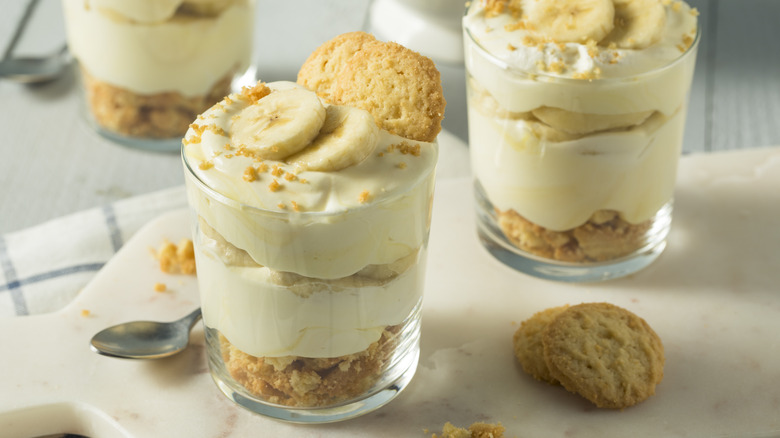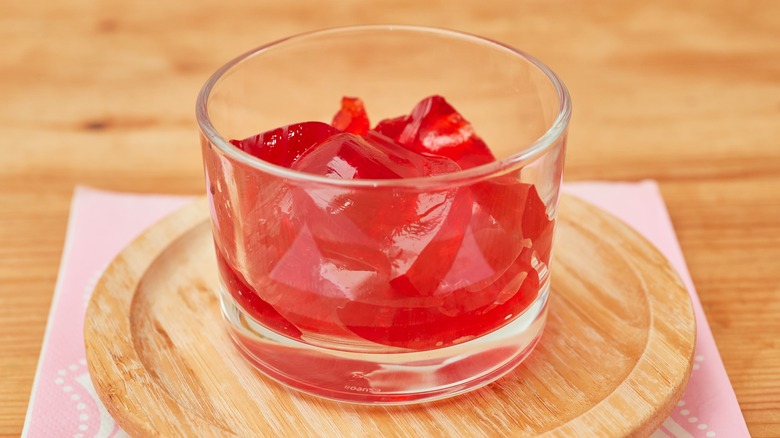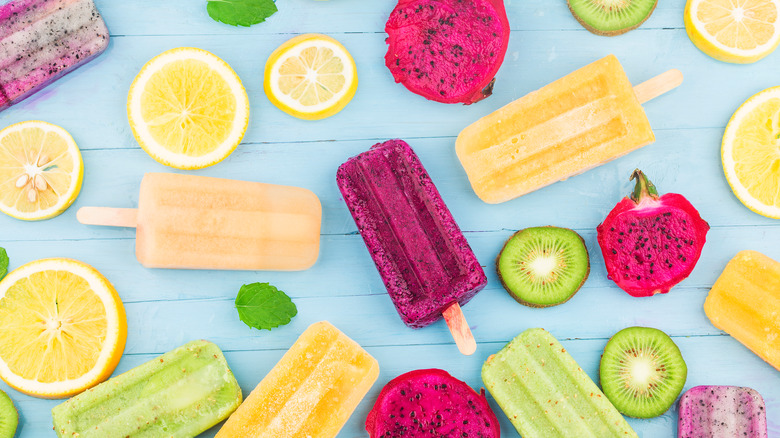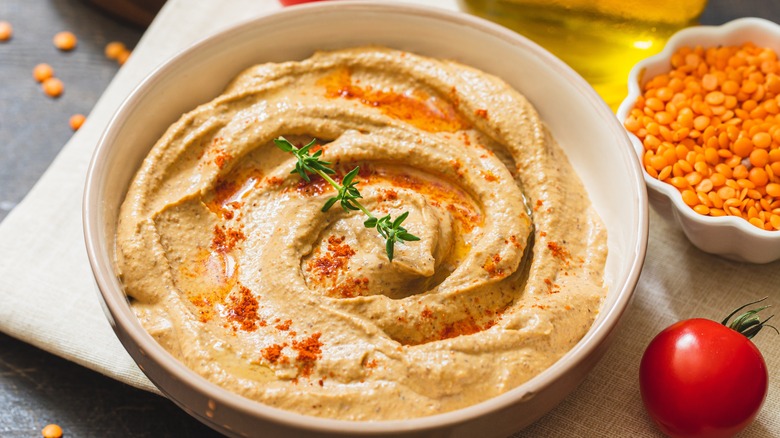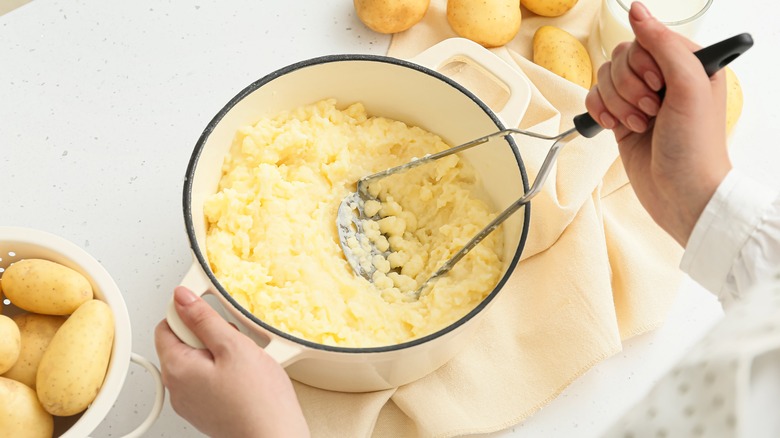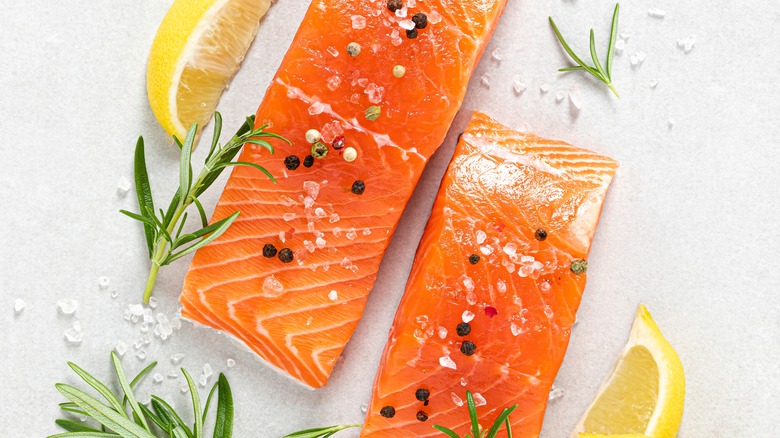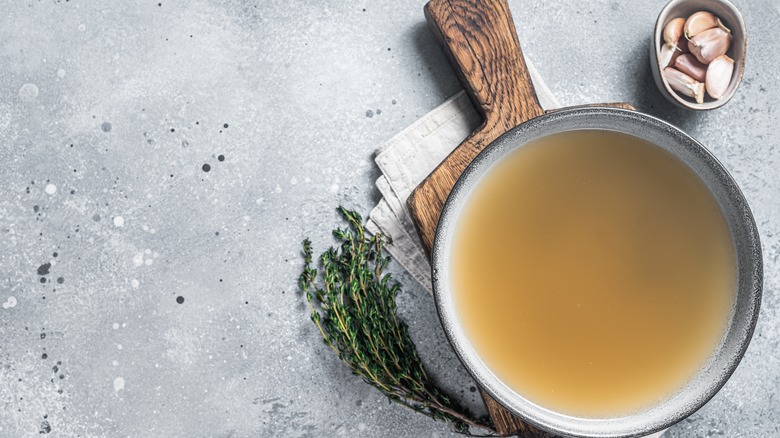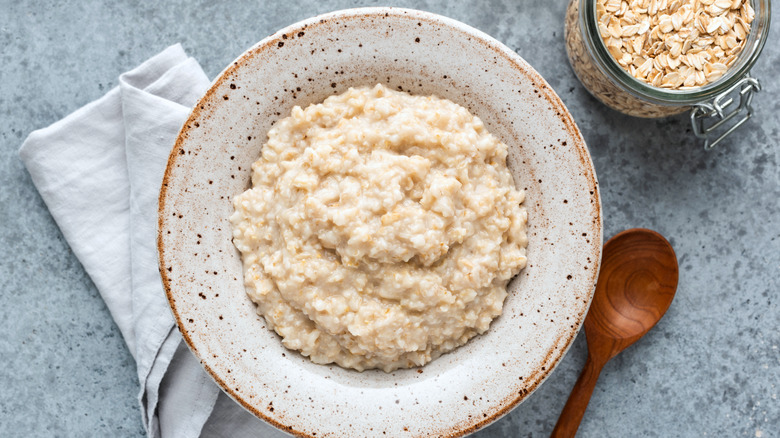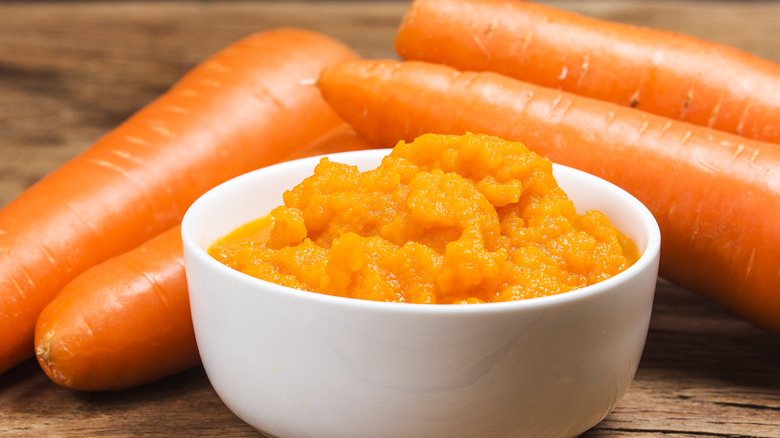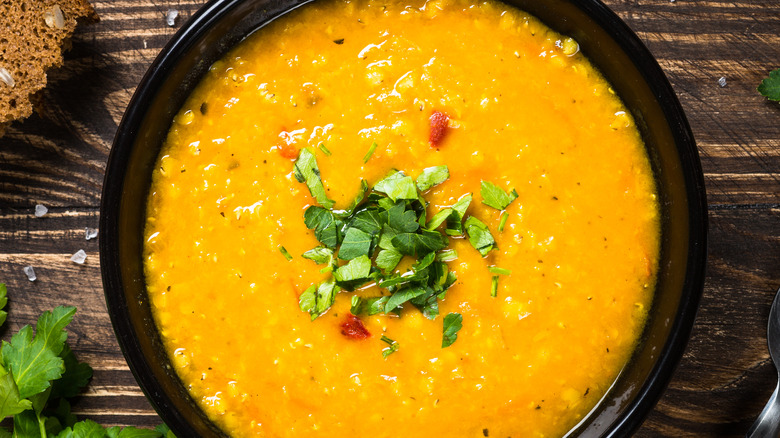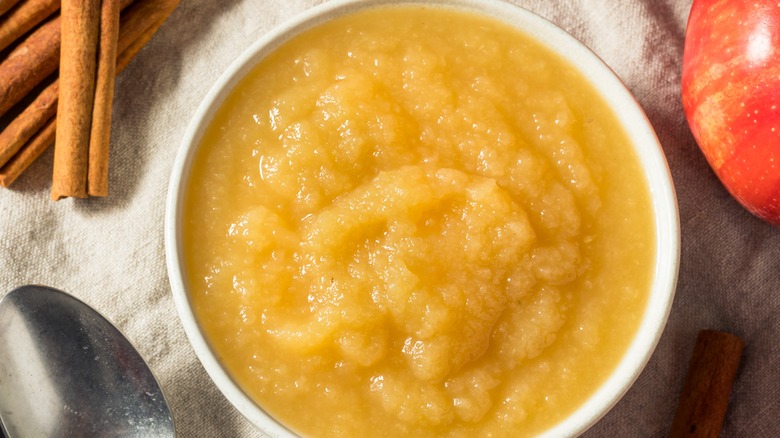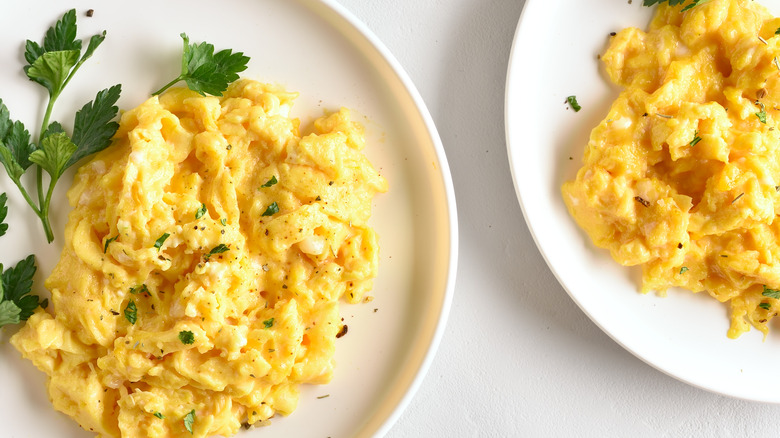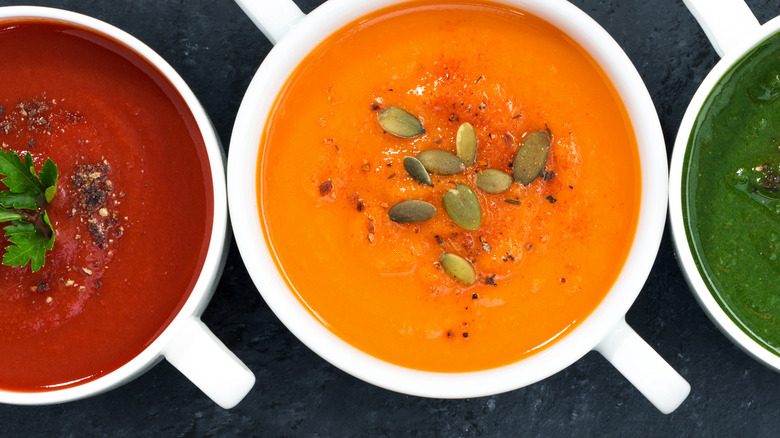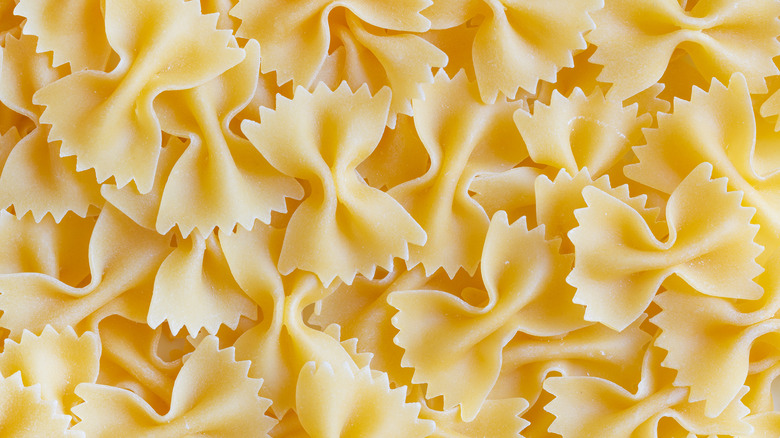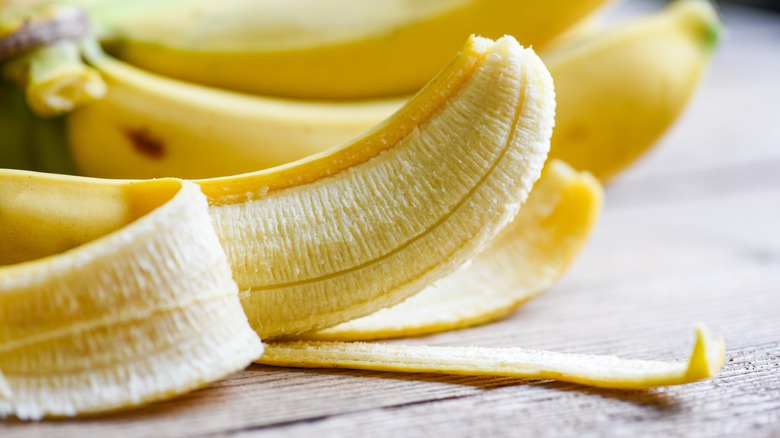16 Soft Foods To Eat When Your Mouth Hurts
Mouth pain is the worst, largely because when you are experiencing it, your appetite doesn't decrease accordingly. Finding yourself stuck in an eternal state of being hungry and not really being able to do anything about it is torture. While there are many reasons your mouth might be in pain, like dental issues such as wisdom teeth removal or an infection, jaw surgery, or even a sports injury — the types of food you can enjoy remain the same.
You need to eat foods that are soft and easy to chew. And, in some cases, foods that don't require any chewing at all because your jaw is too sore to withstand the movement. The key to a speedy recovery is selecting foods that still taste good and contain enough nutrients to keep you healthy. Going hungry when your mouth hurts, or only eating sweets, is a good way to develop a secondary issue during your healing process — especially if it's longer than just a few days. These soft dishes to eat when your mouth hurts are the perfect mix of sweet, savory, and delicious.
1. Pudding
One of the best soft foods to eat when your mouth hurts is pudding. If you are experiencing jaw pain or find chewing too difficult, reach for a cup of pudding instead. Pudding has a soft, smooth texture that will slide right over your tongue, since it is only slightly thicker than a liquid. You can purchase classic options like chocolate, vanilla, or swirl puddings at most grocery stores — or even at the local pharmacy or gas station if you are in a pinch.
If you are feeling up to it and have the time, it is also possible to make a large batch of pudding at home. Most recipes are simple and straightforward, like this no-cook banana pudding option. The best thing to do is to plan ahead, so if you are having an oral surgery done, consider making the pudding a day or two beforehand (or asking a friend or family member to make it for you), so it's ready when you are.
2. Jell-O
Having a sore mouth is a perfect excuse to eat dessert for every meal of the day — snacks too! While you are recovering from your dental work, or waiting on a diagnosis for your discomfort, consider enjoying a cup of Jell-O to get a few calories in. After all, there is a reason that Jell-O is always served in hospitals. According to Tufts Medical Center, medical professionals tend to give their patients Jell-O because its smooth texture makes it easy not only to eat, but also to digest. This is ideal if you are awaiting surgery or still recovering afterward.
The main ingredients in Jell-O are sugar, water, and gelatin, plus whatever is needed to create the flavor of your choice. Jell-O doesn't provide any long-term nutritional benefits. However, even the temporary relief of a cool, sweet treat when you can't really handle chewing anything else is well worth it.
3. Ice cream
When your mouth is bothering you, your oral surgeon or dentist is likely to advise you to ice the impacted area to reduce swelling. If you are tired of holding a bag of frozen peas to your face, one of the best things you can do to reduce your pain level is eat some ice cream. The temperature of the frozen treat can assist in numbing the inside of your mouth, ensuring it doesn't hurt as badly.
A bowl of ice cream also typically contains enough calories to help you toward your goals of consuming enough calories each day, even if you feel like it's painful to eat too much. If you feel a bit bored reaching for plain chocolate or vanilla, consider whipping up some honey lavender ice cream or pear and blue cheese ice cream or even branching out to enjoy frozen custard if you want to try something new. That said, avoid ice cream flavors with chunks of ingredients mixed in like chocolate chips, pretzels, or large pieces of frozen fruit, all of which could hurt to bite down on.
4. Popsicles
Another great way to ice the inside of your mouth when you are experiencing localized pain is by eating popsicles. Because popsicles are typically just frozen fruit extract, sugar, and water, they are gentle on your mouth. If you are concerned about your sugar intake during your recovery, you can make popsicles at home ahead of time. This way, you know exactly what's inside of the sweet treat — and you don't get a stomach ache. There are many easy options available, like these raspberry peach frozen pops or these drenched watermelon ice pops that are extra juicy.
If you can't chew, you don't have to do so to enjoy the flavor of a popsicle. You can just gently suck on the frozen treat and allow it to melt inside your mouth. One thing to be aware of, especially if you have just had oral surgery, is to avoid sucking too hard on popsicles. This is because the suction created in your mouth can sometimes lead to dry sockets. Dry sockets are a painful condition in which the scabs in your mouth become dislodged, exposing the wound underneath (via Mayo Clinic).
5. Hummus
A great savory option to try out when your mouth is bothering you is hummus. Hummus is a delicious dip with origins in the Middle East. It has a very simple ingredients list: chickpeas, tahini, olive oil, garlic, and lemon juice. When blended together, these items create a bold bite with plenty of zing. The food is normally enjoyed as a dipping sauce for things like vegetables and bread — however, if you find chewing too difficult, hummus is nutrient dense, so it makes a great choice on its own as well.
If you want to add a little twist on the classic hummus recipe, there are many variations of the dip available at the grocery store these days. It's also very simple to make at home, too. All you need is a blender. Mix up the basics with an extra ingredient or two for something different. For example, bright pink hummus is made with a little touch of beetroot. If you are more interested in a golden color, try adding carrots.
6. Mashed potatoes
When your mouth hurts, it's possible that you can be uncomfortable to both temperature and texture when trying to have a meal. However, if you are just finding chewing difficult, but are not struggling with warmth, reach for a big helping of mashed potatoes. There are many different ways to prepare the vegetable, depending on your personal taste preferences. However, one that might taste (and feel!) especially good when you are in pain is an extra creamy version. The secret is adding in a little bit of whipping cream or half-and-half to really smooth out the dish's texture, making it even easier to enjoy.
If you find that you have made too much to eat in one sitting, or have an oral surgery coming up and want to meal prep, mashed potatoes are actually really easy to freeze as well. This way, you don't have to worry about cooking when you are in pain. You can just reheat them to enjoy.
7. Salmon
Most meats are too tough to enjoy when your mouth is hurting. Even rare steak, arguably the softest way to cook it, still requires a fair bit of chewing, which can be quite painful. So, if you are looking for a great source of protein, try eating salmon instead. The fish is typically very soft and easy to chew, no matter how it's prepared. It's also a great way to get a healthy dose of omega-3 fatty acids, which help maintain our health on a cellular level, per Harvard T.H. Chan School of Public Health. It's definitely a great substance to consume when you are trying to heal.
There are many different ways to cook salmon, like poaching, grilling, and even baking in the oven. If you are really short on time, or in a lot of pain and don't have the patience to cook a big meal, a good piece of salmon should still be soft and ready to eat after about eight minutes in the air fryer.
8. Broths
When your mouth is hurting, it can be difficult to take in all the nutrients you need. The foods typically available for you to consume are soft and delicious, but not necessarily healthy. If you are experiencing prolonged mouth pain, consider adding a selection of broths to your menu to ensure you are taking in all the vitamins and minerals that you need. Sometimes, soups, even when blended, can still hurt — depending on the intensity of pain in your mouth.
You can make bone broth at home to suit your specific dietary needs, but there is also a growing trend of delicious broths being sold pre-made at most grocery stores. You can use fish, beef, or even chicken stock to create a tasty, nutrient dense alternative for dinner. If you are a vegetarian or vegan, there are also plenty of vegetable broths available on the market for you to enjoy.
9. Oatmeal
Oatmeal (or porridge as it's better known by some folks) is a great breakfast food to enjoy when you aren't feeling your best. The oats cook down to a nice, gooey texture that is really easy to eat without chewing. You also get plenty of nutrients from oatmeal, like magnesium, zinc, and iron, so it's a yummy option to indulge in even after your recovery is over.
Oatmeal comes in a variety of flavors, so if you don't think it tastes very good plain, you can spice it up with cinnamon, allspice, or even paprika for a savory kick. If you don't feel like cooking, a simple bowl of instant oatmeal should do the trick, but overnight oats are the best option for nutrition. You can add things like fresh berries and even cream to this simple breakfast option to enhance its flavor. You could also add more nutrients for your recovery.
10. Steamed and mashed vegetables
If you aren't a fan of mashed potatoes, or are starting to feel a little bored of them while waiting for your mouth to heal, it's okay to branch out to other vegetables. Most other options like carrots, turnips, and even cauliflower, taste pretty good once you steam and mash them up. You can prepare these foods in much the same way you would cook mashed potatoes, even adding in similar ingredients. So if you've never made them before, it won't be too hard to catch on.
In fact, according to Tasting Table, many chefs even use other root vegetables in addition to potatoes in their mashed dishes to round out the flavor. So, when whipping up a mashed vegetable meal, be sure to include all the staples of mashed potatoes, like butter or cream, as well as plenty of salt, pepper, and other spices like garlic or paprika.
11. Mashed lentils
Lentils belong to the food group known as legumes. According to the U.S. Department of Agriculture, legumes are a small subgroup of vegetables. To qualify, the food must have seeds that grow inside of a pod. Foods like beans and peanuts are also legumes. What is really special about legumes is that they have a lot of protein in them as well as fiber, folate, and potassium.
If you are in pain, it can be difficult to eat a healthy and balanced diet, as many soft foods tend to be dessert-like. While recovering from oral surgery, it's fine to enjoy these sweet treats in the short term — but if you are experiencing longer term mouth pain, you need to seek out foods with the vitamins and minerals you need. Lentils are the perfect happy medium, as they are nice and soft but really pack a punch with the nutrients they can deliver to your body.
12. Applesauce
If you want to make applesauce at home, the best way to do so is with plenty of sugar and cinnamon, giving it a delicious dessert-like taste. However, if you are concerned about your sugar intake or find it too sweet, there is a simple fix. Applesauce is still yummy without any added sugar at all, thanks to the natural sugar of the apples.
If you prefer to purchase it at the store instead, you also have plenty of options, as applesauce doesn't just come in plain apple flavors anymore. So, if you feel a bit bored by weeks of eating it, it's easy to spice things up. Most national brands, as well as their grocery store counterparts, sell blends like green applesauce, strawberry mango sauce, apple and banana sauce, and pretty much every other combination that you can think of. Consider using your recovery time as an opportunity to discover new flavors of a food you probably haven't thought twice about since you were a kid.
13. Scrambled eggs
Scrambled eggs are a soft, fluffy, and healthy choice to reach for when your mouth is bothering you. There are a few things you can do to make your eggs just a little bit better. First, be sure to always buy the freshest eggs that you can. To do this, you can seek out a local farmer's market for the best deal. If you purchase from a grocery store, be sure to keep them refrigerated so they last as long as possible. To avoid food poisoning while dealing with mouth pain, always give the eggs a quick sniff to ensure they are still within their expiration date.
Once you've selected them, remember that the key to the most delicious scrambled eggs (and ones that are nice and fluffy so they don't hurt your mouth) is whisking them up! The whisking process traps lots of air inside the mixture, making it the perfect, light consistency.
14. Blended soup
Soups are a great option to eat when you are experiencing mouth pain. No matter what kind you select, most soups are a delicious savory option when you are overloaded on ice cream and popsicles. However, even if soups are typically liquid, they can still have some larger chunks that can hurt to chew. For example, if you or your caretaker decides to include chopped carrots in your chicken soup, it can be painful to bite down on them if they are not cooked enough. The same can be said of tough pieces of steak in a beef soup or chunks in potato soup.
As you progress through your recovery, you might find that your mouth is less sensitive and you are able to lightly chew these items — especially if they have been soaking in the broth. However, at the beginning, it's a good idea to pop the soup in a blender. This way, you can enjoy all the flavors, as well as absorb the nutrients, without torturing yourself.
15. Pasta
Cooked pasta feels great and tastes great when your mouth hurts. The key to enjoying your favorite type of noodle, be it bowtie, spaghetti, or even penne, is ensuring that you cook it just a little bit longer than you normally would. This is because plenty of folks enjoy eating their pasta al dente, which is Italian for "to the tooth," per Dictionary.com. It's a phrase used in the cooking world to describe pasta that is nice and firm, which gets this way due to a shorter boiling time.
However, when your mouth is bothering you, it will be especially difficult to enjoy noodles this way. Any sort of extra chewing or crunching is sure to be excruciating. To avoid this situation, you can add a minute or so onto the manufacturer's recommended cooking time. This will leave you with a softer noodle that is way easier for you to eat.
16. Bananas
Of the many fruits packed with plenty of nutrients, the banana is one that is easy to eat when you can't really chew, due to its soft, malleable texture. In fact, bananas are a favorite choice of mothers who are introducing the world of semi-solid foods to their children. According to What To Expect, babies can begin enjoying the fruit at around six months old — which is well before they even have all their teeth. So, if you have recently had a tooth extracted, take comfort in the fact that eating bananas is perfectly safe, even without all your teeth.
If you are experiencing discomfort biting into the banana, or even chewing a smaller bite, consider mashing the fruit up into smaller slices. Enjoying a banana puree still gives you all the benefits of eating the fruit, without any of the added pressure of hurting your mouth trying to do so.

